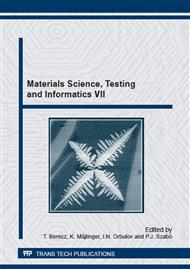p.405
p.413
p.419
p.425
p.435
p.441
p.447
p.453
p.459
Application of 2D-3D Surface Geometrical Features in Tribological Analysis of Ceramics and Ceramic Layers
Abstract:
Microgeometrical characteristics of the surface of engineering components operating in wear condition are important features influencing the wear process of the tribological system. Beside the widely used common 2D roughness parameters – e.g. the Ra, arithmetical mean roughness, Rz, ten point mean roughness, or Rmr, material ratio, etc. – the 3D roughness features (Sa, Sz Smr) provide potentially new means for geometrical description of the operating surfaces. Our paper aims at contributing an overview on the available 2D and 3D features, giving their definition and their potential use in multi-scale characterization of components used especially in wear type loading conditions. An interesting question is the relationship between the 2D and 3D roughness parameters and their information content, relating to tribological problems. Besides giving a systematic overview of the most important parameters applicable in wear analyses we also present examples of 2D and 3D roughness data determined on surface of nitrocarburised steels, as well as silicon nitride ceramics. A special emphasis is placed on those parameters which can be most efficiently used during wear damage analyses of ceramic materials.
Info:
Periodical:
Pages:
435-440
Citation:
Online since:
February 2015
Authors:
Keywords:
Price:
Сopyright:
© 2015 Trans Tech Publications Ltd. All Rights Reserved
Share:
Citation:


